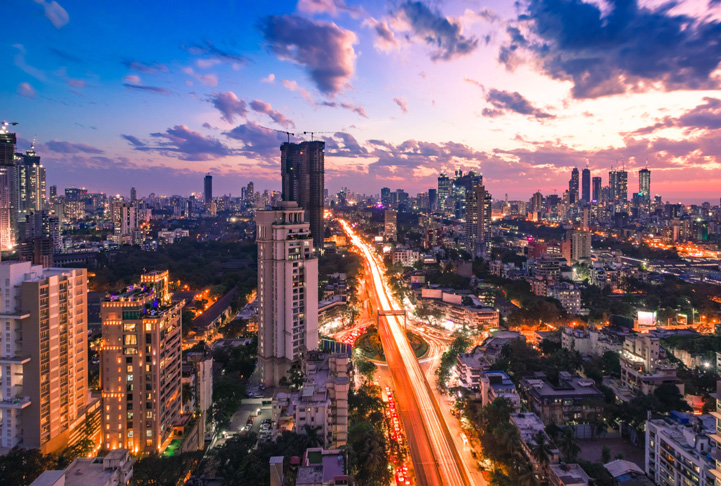Weaker confidence impacts price growth
Capital Values
As with the wider property market, the prime residential market saw a continued slowdown in activity in the first half of 2023. Capital values grew on average by 1.1% across the 30 cities included in the Savills World Cities Prime Residential Index in H1 2023, compared to growth of 0.8% in H2 2022. This left year-on-year growth to June 2023 at 1.9%, the slowest annual growth since December 2020, at the height of the pandemic. Uncertainty surrounding current market conditions has led to caution amongst some buyers and sellers.
Year-to-date, cities in the Asia Pacific region saw the strongest levels of prime price growth. Ten of the 13 APAC cities in the Savills Prime Index reported positive price growth, followed by European locations where seven of the eleven European cities grew above 0%.
Contrasting results across global cities
Price performance over the past six months varied across cities. Despite the economic uncertainties weighing on sentiment, Dubai is still experiencing high levels of prime residential price growth. Capital values grew by 11.2% in the first half of 2023.
Whilst prices are yet to recover to pre-pandemic levels, Mumbai, Cape Town, and Bangkok all saw capital values grow more than 3% in the first half of 2023. Mumbai experienced 4.3% growth in H1, with larger prime residences in greater demand. Cape Town’s prices increased on average by 3.6% and Bangkok’s by 3.1% in H1 as wealthier international buyers returned to both cities.
Scarce supply is fuelling price growth in Sydney in the first half (+3.3%), and in the Spanish cities of Barcelona (+2.8%) and Madrid (+2.2%). These prime markets have attracted wealthy domestic buyers despite rising interest rates. Sydney is starting to see stock increase from a ‘need to sell’ basis, whilst new developments have slowed in Barcelona as regulatory controls in the city have an impact. This includes the city council’s mandate to allocate 30% of the buildable area in new projects to social housing. Madrid’s depleted stock is expanding the prime residential market into areas previously not considered prime, as strong buyer demand both domestically and from wealthy Latin Americans remains ever-present.
Lisbon and Singapore’s prime residential markets, which were the top-performing cities in 2022, experienced weaker growth at the start of 2023. The majority of price growth is expected in the latter part of this year as purchasing decisions are taking longer to complete in Lisbon, and rising land and construction costs are trickling into prime pricing in Singapore.
In London, boroughs that see more international demand performed better over the first half of the year than those where domestic demand dominates, resulting in overall price growth of 0% in the six months to June 2023. Equity was key to transactions; cash buyers have accounted for 71% of prime central London deals and 35% in outer prime London.
Other European cities, namely Paris, Berlin, and Amsterdam, have all fared worse by comparison. Buyers are less active amidst rising interest rates and a lack of high-quality stock. Best-in-class assets continue to perform well, however, creating an opportunity for new developments in this segment of the residential sector.
New York’s prime residential sales fared relatively well compared to the national housing market average. Sales volumes are gradually returning to pre-pandemic ten-year average levels
Paul Tostevin, Director, World Research
Across the Atlantic, New York’s prime residential sales fared relatively well compared to the national housing market average. Sales volumes are gradually returning to pre-pandemic ten-year average levels. Year-to-date sales volumes were down -27% compared to the same period last year, but were 9% above 2019 volumes. The luxury segment proved resilient as the majority of high-end purchases in New York are all-cash transactions. Sales of properties of over $5 million saw a decline, with volumes falling by -12% on 2022’s very high levels; however, they still outperformed 2019 volumes by 27%. Despite this resilience, average prime prices did experience a minor fall over the past six months to June 2023 of -0.7%.
On the West Coast, capital values fell more significantly. In the Californian cities of Los Angeles and San Francisco, prices dropped by -3.0% and -3.7%, respectively, in H1 2023. With stock depleted, many would-be buyers chose to stay in their current homes rather than look for a new property. The Los Angeles Mansion Tax (Measure ULA) was implemented in April this year to help raise funds for homelessness in the city, levying a 4% charge on all residential and commercial real estate sales in the city above $5 million and a 5.5% charge on sales above $10 million. This has moderated the prime segment of the market.
In Asia Pacific, softer market sentiment slowed demand in both Seoul and Shenzhen. Seoul’s average prime prices fell by -1.7% and Shenzhen’s by -3.3% in H1 2023. Rising interest rates from the Bank of Korea knocked investor confidence, even in the prime residential market; this, however, followed a peak of activity within the prime segment in the latter half of 2022. In Shenzhen, ongoing policy restrictions on purchasing eligibility and financing and a weaker economic backdrop led to lacklustre sales performance in the luxury segment.

World city: Mumbai
Outlook
- On average, across our 30 World Cities, our capital value forecast for the remaining six months of 2023 stands at 1.1%, on par with the 1.1% recorded in the first half, and up on the 0.8% achieved in H2 2022.
- We forecast that Dubai will achieve the highest growth for the remainder of 2023, with growth of between 6% and 7.9% expected. Singapore and Bangkok follow, with between 4% and 5.9% forecast for H2 2023. Dubai and Singapore still benefit from the continued relocation of UHNWIs, whilst Bangkok is forecast to continue recovering to pre-pandemic pricing levels.
- Limited supply of prime stock and growing demand for high-end residential product is projected to fuel price growth in European cities such as Milan, Madrid and Barcelona, where 2% to 3.9% price growth is forecast in H2.
- Although the prime segment of the residential market is less reliant upon debt than the mainstream market, Sydney, Seoul, and Amsterdam’s prime market has been impacted by the knock-on effects of rising interest rates.
Albeit to a lesser extent than their mainstream markets, these cities are forecast to see continued reduced levels of competition as people are more reluctant to trade in current uncertain market conditions.
Read the other articles within Savills Prime Residential Index: World Cities below

